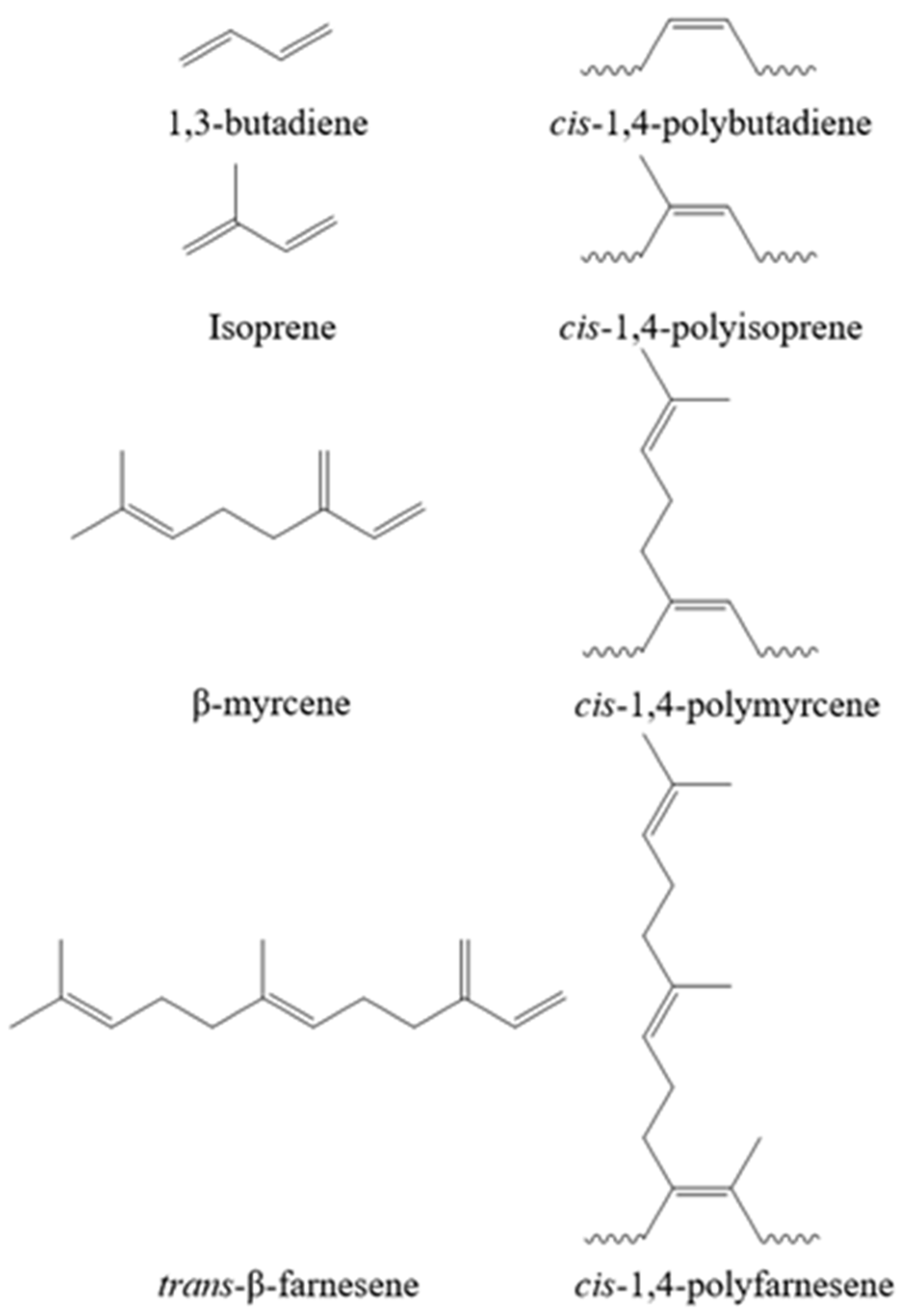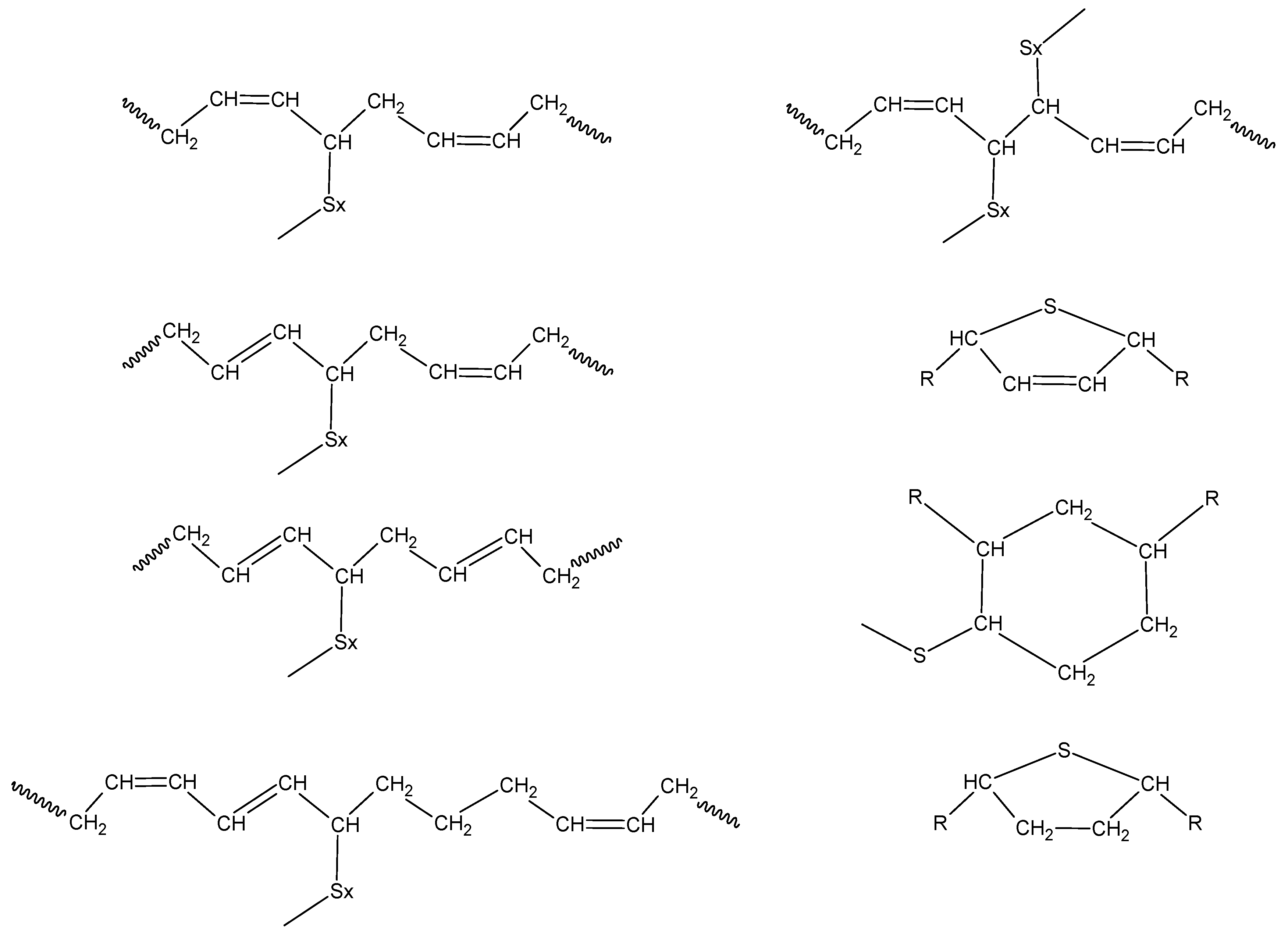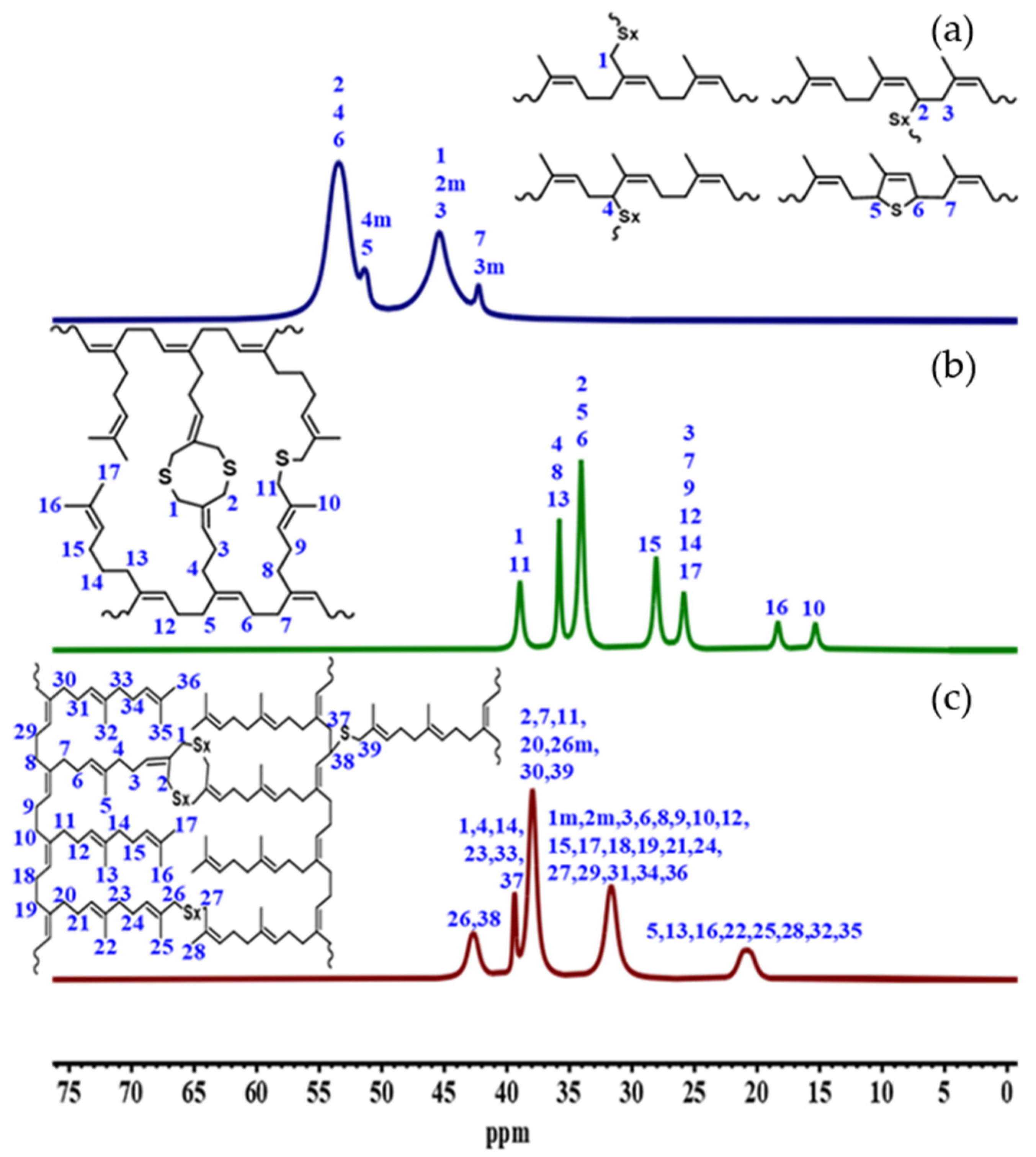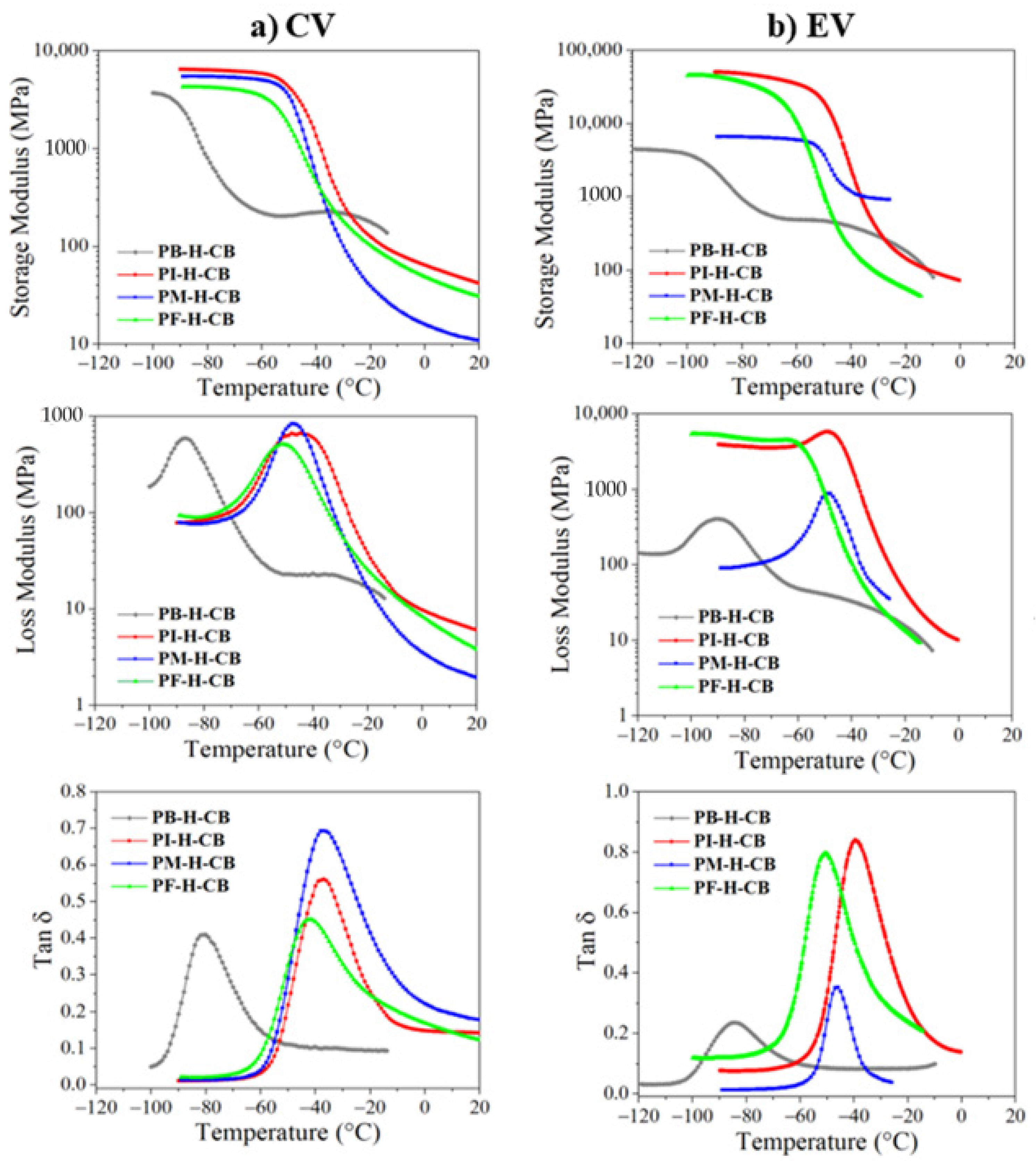Synthesis and Vulcanization of Polymyrcene and Polyfarnesene Bio-Based Rubbers: Influence of the Chemical Structure over the Vulcanization Process and Mechanical Properties
Abstract
:1. Introduction
2. Materials and Methods
2.1. Materials
2.2. Methods
2.2.1. Synthesis of Elastomers
2.2.2. Formulation and Crosslinking
2.3. Characterization
2.3.1. Synthetized Polydienes
2.3.2. Crosslinked Rubbers
3. Results and Discussion
3.1. Synthesis of Rubbers
3.2. Vulcanization of Rubbers
3.3. Crosslinking for Each Vulcanization System
3.4. Crosslinking Density and Mechanical Properties of Rubbers
3.5. Dynamic Mechanical Analysis (DMA) of Crosslinked Materials
4. Conclusions
Supplementary Materials
Author Contributions
Funding
Institutional Review Board Statement
Informed Consent Statement
Data Availability Statement
Acknowledgments
Conflicts of Interest
References
- Statistical Summary of World Rubber Situation; IRSG: London, UK, 2018.
- Magaña, I.; López, R.; Enríquez-Medrano, F.J.; Kumar, S.; Aguilar-Sanchez, A.; Handa, R.; de León-Gómez, R.E.D.; Valencia, L. Bioelastomers: Current state of development. J. Mater. Chem. A 2022, 10, 5019–5043. [Google Scholar] [CrossRef]
- Sarkar, P.; Bhowmick, A.K. Terpene-Based Sustainable Elastomers: Vulcanization and Reinforcement Characteristics. Ind. Eng. Chem. Res. 2018, 57, 5197–5206. [Google Scholar] [CrossRef]
- Lamparelli, D.H.; Paradiso, V.; Della Monica, F.; Proto, A.; Guerra, S.; Giannini, L.; Capacchione, C. Toward More Sustainable Elastomers: Stereoselective Copolymerization of Linear Terpenes with Butadiene. Macromolecules 2020, 53, 1665–1673. [Google Scholar] [CrossRef]
- Wang, Z.; Yuan, L.; Tang, C. Sustainable Elastomers from Renewable Biomass. Accounts Chem. Res. 2017, 50, 1762–1773. [Google Scholar] [CrossRef] [PubMed]
- Sarkar, P.; Bhowmick, A.K. Synthesis, characterization and properties of a bio-based elastomer: Polymyrcene. RSC Adv. 2014, 4, 61343–61354. [Google Scholar] [CrossRef]
- Sahu, P.; Bhowmick, A.K. Redox Emulsion Polymerization of Terpenes: Mapping the Effect of the System, Structure, and Reactivity. Ind. Eng. Chem. Res. 2019, 58, 20946–20960. [Google Scholar] [CrossRef]
- Imhof, P.; van der Waal, J.C. (Eds.) Catalytic Process Development for Renewable Materials; Wiley-VCH Verlag GmbH & Co. KGaA: Weinheim, Germany, 2013; ISBN 9783527656639. [Google Scholar]
- González-Villa, J.; Saldívar-Guerra, E.; León-Gómez, R.E.D.; González, H.R.L.; Infante-Martínez, J.R. Kinetics of the anionic homopolymerizations of ß –myrcene and 4–methylstyrene in cyclohexane initiated by n –butyllithium. J. Polym. Sci. Part A Polym. Chem. 2019, 57, 2157–2165. [Google Scholar] [CrossRef]
- Zhang, S.; Han, L.; Ma, H.; Liu, P.; Shen, H.; Lei, L.; Li, C.; Yang, L.; Li, Y. Investigation on Synthesis and Application Performance of Elastomers with Biogenic Myrcene. Ind. Eng. Chem. Res. 2019, 58, 12845–12853. [Google Scholar] [CrossRef]
- De León, R.D.; López, R.; Valencia, L.; Mendoza, R.; Cabello, J.; Enríquez, J. Towards Bioelastomers via Coordination Polymerization of Renewable Terpenes Using Neodymium-Based Catalyst Systems. Key Eng. Mater. 2018, 779, 115–121. [Google Scholar] [CrossRef]
- Bahena, A.; Magaña, I.; González, H.R.L.; Handa, R.; Enríquez-Medrano, F.J.; Kumar, S.; Carrizales, R.M.; Fernandez, S.; Valencia, L.; Gómez, R.E.D.D.L. Bio-elastomer nanocomposites reinforced with surface-modified graphene oxide prepared via in situ coordination polymerization. RSC Adv. 2020, 10, 36531–36538. [Google Scholar] [CrossRef]
- González-Zapata, J.L.; Enríquez-Medrano, F.J.; González, H.R.L.; Revilla-Vázquez, J.; Carrizales, R.M.; Georgouvelas, D.; Valencia, L.; Gómez, R.E.D.D.L. Introducing random bio-terpene segments to high cis-polybutadiene: Making elastomeric materials more sustainable. RSC Adv. 2020, 10, 44096–44102. [Google Scholar] [CrossRef]
- Koda, D.; Hirata, K. Rubber Composition and Tire. U.S. Patent 9,228,077 B2, 5 January 2016. [Google Scholar]
- McPhee, D.J. Polyfarnesenes. U.S. Patent 8,314,196 B2, 20 November 2012. [Google Scholar]
- Zhang, J.; Lu, J.; Su, K.; Wang, D.; Han, B. Bio-based β-myrcene-modified solution-polymerized styrene–butadiene rubber for improving carbon black dispersion and wet skid resistance. J. Appl. Polym. Sci. 2019, 136, 48159. [Google Scholar] [CrossRef]
- Weems, A.C.; Chiaie, K.R.D.; Yee, R.; Dove, A.P. Selective Reactivity of Myrcene for Vat Photopolymerization 3D Printing and Postfabrication Surface Modification. Biomacromolecules 2019, 21, 163–170. [Google Scholar] [CrossRef] [PubMed]
- Sahu, P.; Bhowmick, A.K. Sustainable self-healing elastomers with thermoreversible network derived from biomass via emulsion polymerization. J. Polym. Sci. Part A Polym. Chem. 2019, 57, 738–751. [Google Scholar] [CrossRef]
- Mangeon, C.; Thevenieau, F.; Renard, E.; Langlois, V. Straightforward Route to Design Biorenewable Networks Based on Terpenes and Sunflower Oil. ACS Sustain. Chem. Eng. 2017, 5, 6707–6715. [Google Scholar] [CrossRef]
- Ren, Y.; Miller, J.T.; Polderman, S.T.; Vo, T.D.; Wallace, A.C.M.; Cue, J.M.O.; Tran, S.T.; Biewer, M.C.; Stefan, M.C. Halide-free neodymium phosphate based catalyst for highly cis-1,4 selective polymerization of dienes. RSC Adv. 2019, 9, 3345–3350. [Google Scholar] [CrossRef] [Green Version]
- Deuri, A.S.; Bhowmick, A.K. Aging of EPDM rubber. J. Appl. Polym. Sci. 1987, 34, 2205–2222. [Google Scholar] [CrossRef]
- Valentín, J.L.; González, J.C.; Mora-Barrantes, I.; Chassé, W.; Saalwächter, K. Uncertainties in the Determination of Cross-Link Density by Equilibrium Swelling Experiments in Natural Rubber. Macromolecules 2008, 41, 4717–4729. [Google Scholar] [CrossRef]
- Sheehan, C.J.; Bisio, A.L. Polymer/Solvent Interaction Parameters. Rubber Chem. Technol. 1966, 39, 149–192. [Google Scholar] [CrossRef]
- Sathi, S.G.; Stocek, R.; Kratina, O. Reversion free high-temperature vulcanization of cis-polybutadiene rubber with the accelerated-sulfur system. Express Polym. Lett. 2020, 14, 823–837. [Google Scholar] [CrossRef]
- Sperling, L.H. Dilute Solution Thermodynamics, Molecular Weights, and Sizes. In Introduction to Physical Polymer Science; John Wiley & Sons Inc: Hoboken, NJ, USA, 2006; pp. 71–143. [Google Scholar]
- Wang, F.; Liu, H.; Zheng, W.; Guo, J.; Zhang, C.; Zhao, L.; Zhang, H.; Hu, Y.; Bai, C.; Zhang, X. Fully-reversible and semi-reversible coordinative chain transfer polymerizations of 1,3-butadiene with neodymium-based catalytic systems. Polymer 2013, 54, 6716–6724. [Google Scholar] [CrossRef]
- López, L.A.V.; Enríquez-Medrano, F.J.; Textle, H.M.; Corral, F.S.; González, H.R.L.; Thomas, C.S.; Gámez, F.H.; Romero, J.L.O.; Gómez, R.E.D.D.L. The Influence of co-catalyst in the Polymerization of 1,3-butadiene Catalyzed by Neodymium Chloride Tripentanolate. J. Mex. Chem. Soc. 2017, 60, 141–147. [Google Scholar] [CrossRef]
- Valencia, L.; Enríquez-Medrano, F.J.; González, H.R.L.; Handa, R.; Caballero, H.S.; Carrizales, R.M.; Olivares-Romero, J.L.; Gómez, R.E.D.D.L. Bio-elastomers based on polyocimene synthesized via coordination polymerization using neodymium-based catalytic systems. RSC Adv. 2020, 10, 36539–36545. [Google Scholar] [CrossRef]
- Akiba, M. Vulcanization and crosslinking in elastomers. Prog. Polym. Sci. 1997, 22, 475–521. [Google Scholar] [CrossRef]
- González, L.; Rodríguez, A.; Valentin, J.L.; Marcos-Fernández, A.; Posadas, P. Conventional and efficient crosslinking of natural rubber effect of heterogeneities on the physical properties. KGK Kautsch. Gummi Kunstst. 2005, 58, 638–643. [Google Scholar]
- Kruželák, J.; Sýkora, R.; Hudec, I. Vulcanization of rubber compounds with peroxide curing systems. Rubber Chem. Technol. 2017, 90, 60–88. [Google Scholar] [CrossRef]
- Kruželák, J.; Sýkora, R.; Hudec, I. Sulphur and peroxide vulcanisation of rubber compounds—Overview. Chem. Pap. 2016, 70, 1533–1555. [Google Scholar] [CrossRef]
- Johnson, B.L.; Wolfangel, R.D. Viscosity-Molecular Weight Relation for Polybutadiene. Effect of Polymerization Conditions on Branching and Cross Linking. Ind. Eng. Chem. 1952, 44, 752–756. [Google Scholar] [CrossRef]
- Bornstein, D.; Pazur, R. The sulfur reversion process in natural rubber in terms of crosslink density and crosslink density distribution. Polym. Test. 2020, 88, 106524. [Google Scholar] [CrossRef]
- Pal, K.; Satpathi, H.; Bhandary, T.; Samui, B.K.; Bhattacharyya, S.; Naskar, K.; Mukhopadhyay, R. Understanding the influence of anti-reversion agent and metal oxide dose on natural rubber–carbon black system. Polym. Eng. Sci. 2021, 61, 2616–2629. [Google Scholar] [CrossRef]
- Dondi, D.; Buttafava, A.; Zeffiro, A.; Palamini, C.; Lostritto, A.; Giannini, L.; Faucitano, A. The mechanisms of the sulphur-only and catalytic vulcanization of polybutadiene: An EPR and DFT study. Eur. Polym. J. 2015, 62, 222–235. [Google Scholar] [CrossRef]
- Wahlen, C.; Blankenburg, J.; Von Tiedemann, P.; Ewald, J.; Sajkiewicz, P.; Müller, A.H.E.; Floudas, G.; Frey, H. Tapered Multiblock Copolymers Based on Farnesene and Styrene: Impact of Biobased Polydiene Architectures on Material Properties. Macromolecules 2020, 53, 10397–10408. [Google Scholar] [CrossRef]
- Mori, M.; Koenig, J.L. A Review of High-Resolution NMR Studies of Vulcanized Elastomers. Annu. Rep. NMR Spectrosc. 1997, 34, 231–299. [Google Scholar] [CrossRef]
- Fetters, L.J.; Lohse, D.J.; Richter, D.; Witten, T.A.; Zirkel, A. Connection between Polymer Molecular Weight, Density, Chain Dimensions, and Melt Viscoelastic Properties. Macromolecules 1994, 27, 4639–4647. [Google Scholar] [CrossRef]
- Callister, W.D.; Rethwisch, D.G. Materials Science and Engineering; John Wiley & Sons Inc: Hoboken, NJ, USA, 2014. [Google Scholar]
- Sperling, L.H. Introduction to Polymer Science. In Introduction to Physical Polymer Science; John Wiley & Sons Inc: Hoboken, NJ, USA, 2006; pp. 1–28. [Google Scholar]
- Nie, Y.; Gu, Z.; Wei, Y.; Hao, T.; Zhou, Z. Features of strain-induced crystallization of natural rubber revealed by experiments and simulations. Polym. J. 2017, 49, 309–317. [Google Scholar] [CrossRef]
- Sainumsai, W.; Toki, S.; Amnuaypornsri, S.; Nimpaiboon, A.; Sakdapipanich, J.; Rong, L.; Hsiao, B.S.; Suchiva, K. Dependence of the onset of strain-induced crystallization of natural rubber and its synthetic analogue on crosslink and entanglement by using synchrotron X-Ray. Rubber Chem. Technol. 2017, 90, 728–742. [Google Scholar] [CrossRef]
- Ikeda, Y.; Junkong, P.; Ohashi, T.; Phakkeeree, T.; Sakaki, Y.; Tohsan, A.; Kohjiya, S.; Cornish, K. Strain-induced crystallization behaviour of natural rubbers from guayule and rubber dandelion revealed by simultaneous time-resolved WAXD/tensile measurements: Indispensable function for sustainable resources. RSC Adv. 2016, 6, 95601–95610. [Google Scholar] [CrossRef]
- Liu, J.; Tang, Z.; Huang, J.; Guo, B.; Huang, G. Promoted strain-induced-crystallization in synthetic cis-1,4-polyisoprene via constructing sacrificial bonds. Polymer 2016, 97, 580–588. [Google Scholar] [CrossRef]
- Hernández, M.; López-Manchado, M.A.; Sanz, A.; Nogales, A.; Ezquerra, T.A. Effects of Strain-Induced Crystallization on the Segmental Dynamics of Vulcanized Natural Rubber. Macromolecules 2011, 44, 6574–6580. [Google Scholar] [CrossRef] [Green Version]
- Zhao, F.; Bi, W.; Zhao, S. Influence of Crosslink Density on Mechanical Properties of Natural Rubber Vulcanizates. J. Macromol. Sci. Part B 2011, 50, 1460–1469. [Google Scholar] [CrossRef]
- Spratte, T.; Plagge, J.; Wunde, M.; Klüppel, M. Investigation of strain-induced crystallization of carbon black and silica filled natural rubber composites based on mechanical and temperature measurements. Polymer 2017, 115, 12–20. [Google Scholar] [CrossRef]
- Kim, D.Y.; Park, J.W.; Lee, D.Y.; Seo, K.H. Correlation between the Crosslink Characteristics and Mechanical Properties of Natural Rubber Compound via Accelerators and Reinforcement. Polymers 2020, 12, 2020. [Google Scholar] [CrossRef] [PubMed]
- Robertson, C.G.; Hardman, N.J. Nature of Carbon Black Reinforcement of Rubber: Perspective on the Original Polymer Nanocomposite. Polymers 2021, 13, 538. [Google Scholar] [CrossRef]
- Abdelsalam, A.A.; Araby, S.; El-Sabbagh, S.; Abdelmoneim, A.; Hassan, M.A. Effect of carbon black loading on mechanical and rheological properties of natural rubber/styrene-butadiene rubber/nitrile butadiene rubber blends. J. Thermoplast. Compos. Mater. 2019, 34, 490–507. [Google Scholar] [CrossRef]
- Robertson, C.G.; Lin, C.J.; Rackaitis, M.; Roland, C.M. Influence of Particle Size and Polymer−Filler Coupling on Viscoelastic Glass Transition of Particle-Reinforced Polymers. Macromolecules 2008, 41, 2727–2731. [Google Scholar] [CrossRef] [Green Version]
- Ahmadijokani, F.; Shojaei, A.; Dordanihaghighi, S.; Jafarpour, E.; Mohammadi, S.; Arjmand, M. Effects of hybrid carbon-aramid fiber on performance of non-asbestos organic brake friction composites. Wear 2020, 452–453, 203280. [Google Scholar] [CrossRef]
- Jafarpour, E.; Shojaei, A.; Ahmadijokani, F. High-performance styrene-butadiene rubber nanocomposites based on carbon nanotube/nanodiamond hybrid with synergistic thermal conduction characteristics and electrically insulating properties. Polymer 2020, 196, 122470. [Google Scholar] [CrossRef]










| Component | Content (phr a) | |||
|---|---|---|---|---|
| CV | EV | |||
| WR b | CB c | WR b | CB c | |
| Rubber | 100 | 100 | 100 | 100 |
| Zinc oxide | 5 | 5 | 5 | 5 |
| Stearic acid | 2 | 2 | 2 | 2 |
| Carbon black N330 | - | 50 | - | 50 |
| Sulfur | 2 | 2 | 0.5 | 0.5 |
| MBTS accelerator | 0.5 | 0.5 | 2 | 2 |
| Rubber | [Monomer]: [Nd] | Mw (Kg/mol) | Ð a | Cis (%) b |
|---|---|---|---|---|
| PB-H | 12,600 | 693 | 3.76 | 99.20 |
| PB-L | 6300 | 302 | 2.91 | 96.04 |
| PI-H | 7900 | 865 | 4.11 | 95.08 |
| PI-L | 3950 | 292 | 2.46 | 94.46 |
| PM-H | 2000 | 791 | 3.80 | 95.83 |
| PM-L | 1000 | 332 | 3.54 | 95.78 |
| PF-H | 780 | 1161 | 3.98 | 95.56 |
| PF-L | 600 | 456 | 4.92 | 95.42 |
| Sample | Rubber | Tensile Strength (MPa) | Elongation at Break (%) | Moduli at 100% (MPa) | Moduli at 200% (MPa) | Moduli at 300% (MPa) | Crosslinking Density (mol/cm3 × 10−3) | Hardness (Shore A) | Compression Set (%) |
|---|---|---|---|---|---|---|---|---|---|
| 1CV | PB-H | 1.92 ± 0.75 | 674 ± 121 | 0.53 ± 0.09 | 0.76 ± 0.09 | 0.96 ± 0.12 | 9.45 | 54.6 ± 3.6 | 33.77 ± 6.36 |
| 2CV | PB-H-CB a | 5.92 ± 0.57 | 231 ± 24 | 2.85 ± 0.28 | 5.09 ± 0.64 | - | 29.20 | 80.4 ± 2.3 | 59.19 ± 2.52 |
| 3CV | PI-H | 1.72 ± 1.17 | 1263 ± 25 | 0.17 ± 0.04 | 0.24 ± 0.03 | 0.29 ± 0.03 | 4.46 | 17.8 ± 2.3 | 96.68 ± 3.23 |
| 4CV | PI-H-CB a | 8.17 ± 0.51 | 419 ± 55 | 1.95 ± 0.13 | 3.83 ± 0.31 | 5.86 ± 0.46 | 24.80 | 73.4 ± 3.0 | 79.20 ± 1.71 |
| 5CV | PM-H | 0.55 ± 0.10 | 488 ± 32 | 0.11 ± 0.01 | 0.21 ± 0.01 | 0.31 ± 0.03 | 6.09 | 23.2 ± 1.3 | 83.43 ± 11.63 |
| 6CV | PM-H-CB a | 2.27 ± 0.44 | 225 ± 65 | 1.14 ± 0.15 | 2.08 ± 0.16 | - | 21.2 | 62.6 ± 4.4 | 68.32 ± 2.42 |
| 7CV | PF-H | 0.20 ± 0.0 | 181 ± 24 | 0.09 ± 0.01 | - | - | 6.44 | 22.4 ± 3.2 | 99.50 ± 0.87 |
| 8CV | PF-H-CB a | 2.97 ± 0.05 | 231 ± 13 | 1.16 ± 0.12 | 2.52 ± 0.13 | - | 27.30 | 57.2 ± 6.8 | 84.63 ± 1.00 |
| 9CV | PB-L | 0.75 ± 0.06 | 663 ± 63 | 0.25 ± 0.00 | 0.35 ± 0.01 | 0.42 ± 0.02 | 3.38 | 36.0 ± 1.0 | 62.77 ± 4.05 |
| 10CV | PB-L-CB a | 5.15 ± 1.30 | 281 ± 38 | 1.74 ± 0.19 | 3.52 ± 0.60 | - | 21.00 | 72.2 ± 2.3 | 38.79 ± 2.42 |
| 11CV | PI-L | 1.20 ± 0.14 | 988 ± 48 | 0.13 ± 0.01 | 0.20 ± 0.01 | 0.26 ± 0.01 | 3.76 | 18.0 ± 1.6 | 98.43 ± 1.37 |
| 12CV | PI-L-CB a | 8.12 ± 0.44 | 375 ± 20 | 1.94 ± 0.06 | 4.27 ± 0.10 | 6.63 ± 0.13 | 24.10 | 81.4 ± 3.4 | 75.14 ± 8.73 |
| 13CV | PM-L | 0.20 ± 0.0 | 481 ± 55 | 0.03 ± 0.00 | 0.06 ± 0.00 | 0.10 ± 0.01 | 2.66 | 12.8 ± 1.3 | 97.61 ± 4.14 |
| 14CV | PM-L-CB a | 2.15 ± 0.44 | 250 ± 41 | 0.87 ± 0.14 | 1.80 ± 0.29 | - | 24.00 | 71.0 ± 2.2 | 75.24 ± 1.92 |
| 15CV | PF-L | - | - | - | - | - | - | - | - |
| 16CV | PF-L-CB a | 0.57 ± 0.05 | 156 ± 24 | 0.37 ± 0.13 | - | - | - | 62 ± 5.9 | 69.39 ± 10.75 |
| Sample | Rubber | Tensile Strength (MPa) | Elongation at Break (%) | Moduli at 100% (MPa) | Moduli at 200% (MPa) | Moduli at 300% (MPa) | Crosslinking Density (mol/cm3 × 10−3) | Hardness (Shore A) | Compression Set (%) |
|---|---|---|---|---|---|---|---|---|---|
| 1EV | PB-H | 1.32 ± 0.13 | 413 ± 48 | 0.59 ± 0.04 | 0.84 ± 0.05 | 1.06 ± 0.06 | 13.50 | 41.8 ± 2.9 | 54.88 ± 6.87 |
| 2EV | PB-H-CB a | 7.10 ± 0.42 | 313 ± 14 | 2.48 ± 0.10 | 4.36 ± 0.21 | 6.58 ± 0.35 | 29.70 | 69.4 ± 2.4 | 35.25 ± 0.57 |
| 3EV | PI-H | 4.2 ± 0.54 | 1000 ± 0 | 0.35 ± 0.02 | 0.53 ± 0.02 | 0.72 ± 0.02 | 9.60 | 11.0 ± 1.2 | 100.00 ± 0.0 |
| 4EV | PI-H-CB a | 10.68 ± 0.98 | 400 ± 46 | 2.27 ± 0.22 | 5.03 ± 0.66 | 8.09 ± 0.99 | 29.20 | 68.8 ± 2.6 | 56.39 ± 0.37 |
| 5EV | PM-H | 0.63 ± 0.05 | 438 ± 14 | 0.13 ± 0.01 | 0.26 ± 0.01 | 0.39 ± 0.01 | 7.17 | 15.8 ± 1.3 | 32.11 ± 6.15 |
| 6EV | PM-H-CB a | 6.45 ± 0.58 | 381 ± 47 | 1.39 ± 0.37 | 3.16 ± 0.57 | 5.06 ± 0.50 | 32.30 | 61.2 ± 4.1 | 34.47 ± 8.60 |
| 7EV | PF-H | 0.20 ± 0.0 | 313 ± 52 | 0.07 ± 0.00 | 0.14 ± 0.01 | 0.21 ± 0.03 | 5.74 | 6.0 ± 1.0 | 68.71 ± 19.25 |
| 8EV | PF-H-CB a | 4.30 ± 0.30 | 369 ± 24 | 0.87 ± 0.21 | 1.93 ± 0.45 | 3.06 ± 0.72 | 22.30 | 55.60 ± 2.9 | 43.74 ± 3.74 |
| 9EV | PB-L | 1.18 ± 0.29 | 825 ± 189 | 0.27 ± 0.08 | 0.42 ± 0.07 | 0.55 ± 0.10 | 6.11 | 53.2 ± 3.6 | 81.89 ± 1.20 |
| 10EV | PB-L-CB a | 7.98 ± 0.87 | 363 ± 32 | 1.62 ± 0.68 | 3.56 ± 1.67 | 5.83 ± 2.36 | 21.90 | 67.6 ± 2.3 | 37.55 ± 3.41 |
| EV | PI-L | 2.48 ± 0.10 | 1000 ± 0 | 0.19 ± 0.00 | 0.30 ± 0.00 | 0.41 ± 0.01 | 5.75 | 11.6 ± 2.7 | 98.14 ± 2.14 |
| 12EV | PI-L-CB a | 8.53 ± 0.99 | 431 ± 24 | 1.54 ± 0.19 | 3.63 ± 0.47 | 6.03 ± 0.68 | 17.50 | 75.6 ± 2.7 | 67.06 ± 14.99 |
| 13EV | PM-L | 0.23 ± 0.05 | 481 ± 69 | 0.03 ± 0.02 | 0.07 ± 0.02 | 0.13 ± 0.04 | 3.50 | 9.8 ± 1.3 | 100.00 ± 0.0 |
| 14EV | PM-L-CB a | 2.35 ± 0.13 | 331 ± 24 | 0.62 ± 0.06 | 1.49 ± 0.10 | 2.18 ± 0.10 | 19.60 | 52.2 ± 2.2 | 61.47 ± 5.31 |
| 15EV | PF-L | - | - | - | - | - | - | - | - |
| 16EV | PF-L-CB a | 0.95 ± 0.06 | 231 ± 13 | 0.43 ± 0.04 | 0.89 ± 0.02 | - | - | 45 ± 3.9 | 71.31 ± 4.60 |
| Sample | Tg (°C) | Maximum Value of Tan δ | Loss Modulus at −40 °C (MPa) | Storage Modulus at −40 °C (MPa) |
|---|---|---|---|---|
| CV-PB-H | −78 | 0.97 | 3.58 | 29.61 |
| CV-PI-H | −34 | 1.48 | 251 | 399.9 |
| CV-PM-H | −42 | 1.43 | 95.63 | 70.17 |
| CV-PF-H | −36 | 0.83 | 75.84 | 137 |
| EV-PB-H | −79 | 0.26 | 10.99 | 159.7 |
| EV-PI-H | −37 | 2.16 | 692.5 | 441.1 |
| EV-PM-H | −45 | 0.88 | 62.2 | 88.29 |
| EV-PF-H | −52 | 1.95 | 3.28 | 5.16 |
| CV-PB-H-CB a | −81 | 0.41 | 23.37 | 223.4 |
| CV-PI-H-CB a | −37 | 0.56 | 60.1 | 1353 |
| CV-PM-H-CB a | −37 | 0.69 | 405.3 | 513.2 |
| CV-PF-H-CB a | −42 | 0.45 | 207.6 | 459 |
| EV-PB-H-CB a | −84 | 0.23 | 32.84 | 394.1 |
| EV-PI-H-CB a | −40 | 0.84 | 1980 | 2420 |
| EV-PM-H-CB a | −46 | 0.35 | 219.3 | 1188 |
| EV-PF-H-CB a | −51 | 0.79 | 109.9 | 204.5 |
Publisher’s Note: MDPI stays neutral with regard to jurisdictional claims in published maps and institutional affiliations. |
© 2022 by the authors. Licensee MDPI, Basel, Switzerland. This article is an open access article distributed under the terms and conditions of the Creative Commons Attribution (CC BY) license (https://creativecommons.org/licenses/by/4.0/).
Share and Cite
Banda-Villanueva, A.; González-Zapata, J.L.; Martínez-Cartagena, M.E.; Magaña, I.; Córdova, T.; López, R.; Valencia, L.; Medina, S.G.; Rodríguez, A.M.; Soriano, F.; et al. Synthesis and Vulcanization of Polymyrcene and Polyfarnesene Bio-Based Rubbers: Influence of the Chemical Structure over the Vulcanization Process and Mechanical Properties. Polymers 2022, 14, 1406. https://doi.org/10.3390/polym14071406
Banda-Villanueva A, González-Zapata JL, Martínez-Cartagena ME, Magaña I, Córdova T, López R, Valencia L, Medina SG, Rodríguez AM, Soriano F, et al. Synthesis and Vulcanization of Polymyrcene and Polyfarnesene Bio-Based Rubbers: Influence of the Chemical Structure over the Vulcanization Process and Mechanical Properties. Polymers. 2022; 14(7):1406. https://doi.org/10.3390/polym14071406
Chicago/Turabian StyleBanda-Villanueva, Arnulfo, José Luis González-Zapata, Manuel Eduardo Martínez-Cartagena, Ilse Magaña, Teresa Córdova, Ricardo López, Luis Valencia, Sergio García Medina, Alejandro Medina Rodríguez, Florentino Soriano, and et al. 2022. "Synthesis and Vulcanization of Polymyrcene and Polyfarnesene Bio-Based Rubbers: Influence of the Chemical Structure over the Vulcanization Process and Mechanical Properties" Polymers 14, no. 7: 1406. https://doi.org/10.3390/polym14071406
APA StyleBanda-Villanueva, A., González-Zapata, J. L., Martínez-Cartagena, M. E., Magaña, I., Córdova, T., López, R., Valencia, L., Medina, S. G., Rodríguez, A. M., Soriano, F., & Díaz de León, R. (2022). Synthesis and Vulcanization of Polymyrcene and Polyfarnesene Bio-Based Rubbers: Influence of the Chemical Structure over the Vulcanization Process and Mechanical Properties. Polymers, 14(7), 1406. https://doi.org/10.3390/polym14071406







